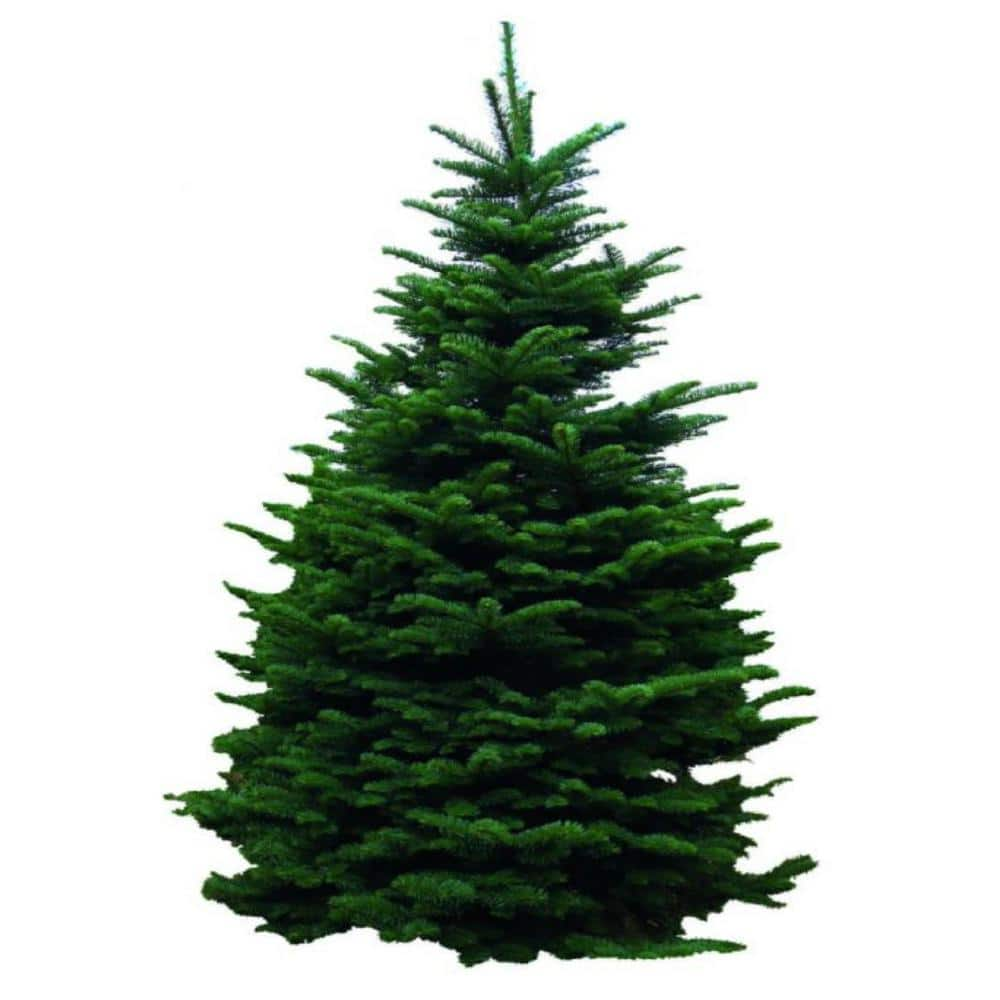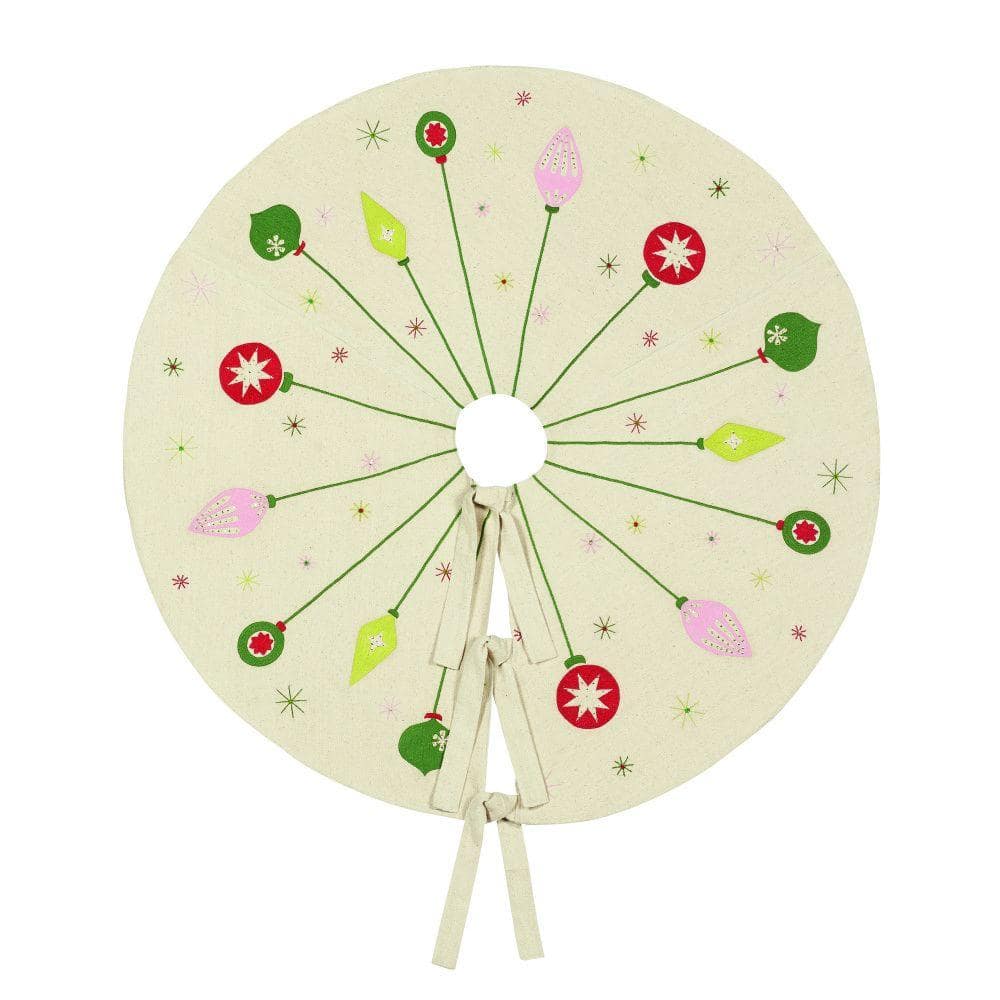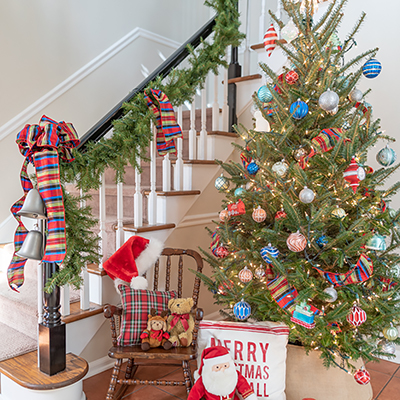Real Christmas Trees Buying Guide

Last updated February 3, 2025
Nothing signals the start of the holidays quite like a fresh-cut, real Christmas tree that fills your home with the festive scent of the season. This guide will teach you about different types of real Christmas trees. You will also find care tips to help you and your family to have the best real Christmas trees.
If artificial Christmas trees are more your style, learn more about them with our educational guide.
Note: Live trees will be in stores nationwide starting late November.
Table of Contents
Environmental Benefits of Live Christmas Trees
Black Hills Spruce
Colorado Blue Spruce
Douglas Fir
Eastern White Pine
Fraser Fir
Environmental Benefits of Live Christmas Trees

Live Christmas trees are a renewable resource, with hundreds of thousands of acres dedicated to their growth. Christmas tree farms raise and harvest different varieties of trees. This virtually eliminates the harvesting of trees in the wild, which can deplete valuable forests. Most types of real Christmas trees take approximately seven years to reach maturity. For every tree that is harvested, anywhere from one to three more seedlings are planted.
Recycling programs located in most communities turn your used tree into useful mulch. Many of our locations offer Christmas tree recycling free of charge. Call your local store to find out if they are participating.
In some areas, recycled trees are also being used to create habitats for fish and other aquatic life in local ponds and lakes, as well as helping to slow erosion. When you choose from the different types of Christmas trees below, consider this important part of its life cycle.
Safety Tip: It is not safe for cats or dogs to eat pine needles or drink Christmas tree water. Monitor your pets closely and cover the tree stands to ensure their safety.
Black Hills Spruce

There are many types of Christmas trees. But the Black Hills spruce tree stands out, with its dark green color, symmetrical shape and conical crown.
- 1/2- to 3/4-inch needles
- Dense, full-coverage foliage
- Sturdy branches can hold heavier ornaments
- Fair needle retention
- Work well in small spaces
Colorado Blue Spruce

Colorado blue spruce trees have a dark blue-gray to silvery blue color, pyramidal shape and conical crown.
- 1- to 1 1/2-inch needles
- Symmetrical form
- Excellent needle retention
- Popular Christmas tree type for living trees and landscaping
- Works well in small spaces
- Will last longer than other varieties
- Pleasant fragrance
Douglas Fir

Douglas fir trees can be dark green or blue green in color and have a pyramidal shape.
- 1- to 1 1/2-inch needles
- Sweet, subtle scent
- Commonly available
- Long-lasting needle
Eastern White Pine

The Eastern white pine tree has a gorgeous green color with a conical shape.
- 2 1/2- to 5-inch needles
- Little or no fragrance
- May be better for allergy sufferers, especially if severe
- Soft, flexible needles
- Not ideal for heavy ornaments
Fraser Fir

Fraser fir are types of Christmas trees with a dark green color and pyramidal shape.
- 1/2- to 1-inch needles
- Strong branches ideal for heavy ornaments
- Excellent needle retention
- Fresh fragrance
Grand Fir

Grand fir trees have a dark green color and a symmetrical shape with a rounded crown.
- 1- to 1 1/2-inch needles
- Strong fragrance
- Needles have a glossy appearance
Noble Fir

Noble fir trees are blue-grey with silver in color and have a pyramidal shape with upturned needles.
- 1-inch needles
- Long-lasting needle life
- Stiff branches well-suited for heavier ornaments
- Pleasing aroma
- Often used to create swags, garlands and wreaths
Norway Spruce

Norway spruce trees have a dark green color and triangular shape.
- 1/2- to 1-inch needles
- Soft, subtle scent
- Fair needle retention
Scotch Pine

Scotch pine trees range from bright green to blue green in color and have a conical shape.
- 1- to 3-inch needles
- Stiff, sturdy branches for supporting heavy decorations
- Lasting aroma
- Excellent needle retention
White/Concolor Fir

White, or concolor fir trees, have a blue-green color and pyramidal shape.
- 1 1/2- to 3-inch needles
- Release a pleasing citrus aroma when the needles are crushed
- Good needle retention
White Spruce

The white spruce Christmas tree has a symmetrical shape with a conical crown.
- 1/2- to 3/4-inch needles
- Dense, full-coverage foliage
- Sturdy branches that can hold heavier ornaments
- Crushed needles release an unpleasant odor
- Fair needle retention
How to Select the Best Real Christmas Tree

When selecting the best real Christmas trees for your home, look for those with a bright, vibrant coloring. Because fresh-cut trees have a limited life, purchase one that was recently harvested. Most types of Christmas trees that are freshly cut usually last between four and six weeks. So be careful not to purchase too early; sometime around Thanksgiving is ideal.
When choosing the location for your live Christmas tree, select a spot that is cool and free from drafts. Also double-check that the tree is located away from heat sources, such as vents, fireplaces or appliances. This helps the tree retain moisture and remain healthy.
Christmas tree height is an important consideration. Once you’ve determined your ideal Christmas tree location, measure the available height and width of the area. Measure your chosen area before buying your tree to ensure that you select one that fits.
Remember when shopping: the taller the tree, the larger the base. Also make sure to allow an appropriate amount of space between the tree and the ceiling for a Christmas tree topper.
Upon purchase, we will cut the bottom inch or two of your tree's trunk, in order to improve water absorption once you arrive home. Put your newly cut tree in water within one hour of cutting the trunk.
Selection tips:
- Needles that look dull and listless can indicate dryness or age.
- Shake the tree and observe how many needles it sheds. While some needle loss is normal on any tree, the best real Christmas trees should retain the vast majority of their needles.
- Withered bark on the outer twigs and branches indicates excessive dryness.
- Fir needles that are fresh and well-hydrated snap crisply when bent.
- Inspect fresh-cut trees for the presence of insects and other pests.
- If you tend to hang heavy ornaments, lightly pull on the tree branches to test their strength.
- Be sure to select a tree that fits your stand, and vice versa. Christmas tree stands should have a minimum capacity of 1-quart of water for every inch of trunk diameter.
Live Christmas Tree Safety and Care

Keeping your tree hydrated is the key to maintaining a healthy, vibrant display throughout the holiday season. Trees can consume as much as a gallon or more of water per day, depending on the type and size. Make sure your stand has enough depth to keep the base of the trunk submerged in water at all times.
Beyond its appearance, having a well-hydrated tree provides natural protection against fire hazards. To keep you and your family safe during the holidays, you should water your tree every day, without exception. Here are some other tips to follow on how to safely care for your live Christmas tree.
- Check water daily and make sure that the base of the tree is always covered.
- Water your tree using plain tap water with no additives for best results.
- Living Christmas trees (trees with root systems) should only be located indoors for between three and 10 days.
- If you live in a cold climate, before bringing the tree indoors, let it rest in a cool part of the home, like a garage. Reverse the procedure when returning it to the yard.
- Recycle all types of real Christmas trees at the end of the season through your local community program.
You may also consider a Christmas tree watering system. They can keep your fresh-cut tree thriving all season long by delivering a constant supply of water straight to the base of your tree.
Decorating with Ornaments and Lights

While eye-catching on its own, at some point, you’ll want to decorate your Christmas tree. Here are some ways to safely hang up your lights and ornaments.
- Use smaller, less heat-intensive Christmas tree lights, such as mini lights or LEDs, as they will reduce drying.
- Always inspect electrical and light cords for damage or wear before hanging them. And be sure to discard any defective ones immediately.
- Use only UL-listed lighting, which has been tested by an independent agency.
- Always unplug and turn off lights when leaving the house or going to bed. You may also use an automatic timer to turn lights off and on.
- When hanging large Christmas tree ornaments, check to make sure the branch doesn't significantly droop under the weight.
- Take extra precautions to ensure your tree will not be easily toppled.
- Clean up pine needles on a regular basis, especially if you have children or pets in the house. Christmas tree skirts can help contain pine needles and create a seasonal backdrop for gifts under the tree. Tree bags can also be used to easily dispose of your tree without scattering needles, branches and other debris.
Find the best real Christmas trees for your family. Shop our selection of holiday decor online or at your local Home Depot. Each of our freshly cut trees is harvested with care and replaced with a new seedling in the spring.
We also have a wide selection of artificial Christmas trees that come in various colors and styles. When you shop from our Christmas tree lot, an associate will prep, net and load the tree onto your car, so all you have to worry about is how to decorate it.
Save time with our app or shop online for all the Christmas lights, ornaments and garland you need to trim the tree and deck the halls. The Home Depot delivers online orders when and where you need them. Real Christmas trees purchased online are available for free delivery, as well.































